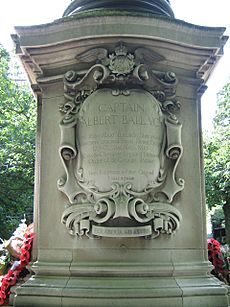Statue of Captain Albert Ball facts for kids
A special statue of Captain Albert Ball stands in Nottingham Castle Gardens. This is in the city of Nottingham, England. The statue is made of bronze by the artist Henry Poole.
It shows a British fighter pilot named Captain Albert Ball. He was a hero who received the VC and many other awards. Next to him is a symbolic female figure. They stand on a stone base designed by Edwin Alfred Rickards. The memorial was first shown to the public in 1921. It is now a very important historical monument.
Contents
Who Was Captain Albert Ball?
Albert Ball was born in Nottingham in 1896. His father, also named Albert Ball, was a local businessman and politician. In September 1914, the First World War began. Albert Ball joined the army soon after. He became a junior officer in the Sherwood Foresters regiment.
Becoming a Pilot in World War I
Albert Ball learned to fly planes on his own. In January 1916, he joined the Royal Flying Corps as a pilot. He flew missions to gather information in France starting in February 1916. He then moved to a fighter plane unit in May 1916. Soon, he shot down his first enemy aircraft.
Within a year, he had shot down 44 enemy planes for sure. He also likely shot down 25 more. Ball became very famous for his bravery in the air. Even the German pilot Manfred von Richthofen, known as the "Red Baron," called him "the best English flying man."
Awards and Legacy
Ball was promoted to acting captain in August 1916. He received many important awards for his courage. These included the Military Cross and the Distinguished Service Order. He also received two special additions to his Distinguished Service Order.
Captain Ball died when his plane crashed on May 7, 1917. He was only 20 years old. A month later, he was given the Victoria Cross. This is the highest award for bravery in the British military. He also received awards from France and Russia.
Albert Ball was buried in a cemetery in France. His father bought the field where his plane crashed. He put up another memorial there to remember his son.
The Statue's Design
The bronze statue by Henry Poole is in the beautiful grounds of Nottingham Castle. This area has many other old and important buildings. There are also other war memorials nearby.
How the Statue Was Made
The city of Nottingham asked for this memorial to be built. People donated money to pay for it. The statue shows Albert Ball as a life-size figure. He is standing in his flying uniform. His hands are on his belt, and he is looking up at the sky.
Behind him is a robed woman standing on clouds. This symbolic figure represents "Air." She gently rests one hand on Ball's shoulder. With her other hand, she points upwards. This design reminds people of old paintings where saints are shown going up to heaven.
Details of the Plinth
The statue stands on a stone base called a plinth. It was designed by Edwin Alfred Rickards. Two sides of the plinth have carvings. These show an S.E.5a biplane. One plane flies over trenches, and the other flies above clouds.
The other two sides have special messages carved into them. Each message includes the motto of the Royal Air Force: "Per ardua ad astra". This means "By labour to the stars."
One message lists Ball's name and awards. It says: "CAPT. ALBERT BALL V.C. / 7TH ROBIN HOOD BATTALION SHERWOOD FORESTERS / ATTACHED ROYAL FLYING CORPS, DSO (2 BARS) MC / CROIX DE CHEVALIER, LEGION D'HONNEUR, / ORDER OF ST GEORGE (RUSSIAN) / HON. FREEMAN OF THE CITY OF NOTTINGHAM / PER ARDUA AD ASTRA".
The other message talks about his bravery and death. It reads: "IN THE AIR / HE GAVE MOST CONSPICUOUS / AND GALLANT SERVICE TO / HIS COUNTRY AND WAS KILLED / IN ACTION FIGHTING GLORIOUSLY / MAY 7TH 1917 AGED 20 YEARS / PER ARDUA AD ASTRA".
The plinth sits on a base made of grey granite. This base has three steps. It also has bronze decorations. These include eternal flames, a feather, a laurel wreath, and decorative feet.
Unveiling the Memorial
The memorial was officially shown to the public on September 8, 1921. Air Marshal Sir Hugh Trenchard unveiled it. He was a very important leader in the Royal Flying Corps. During the ceremony, a group of RAF planes flew overhead.
A smaller bronze copy of Poole's statue model is kept at the National Portrait Gallery, London. Albert Ball's parents gave it to the gallery in 1929.
Images for kids







